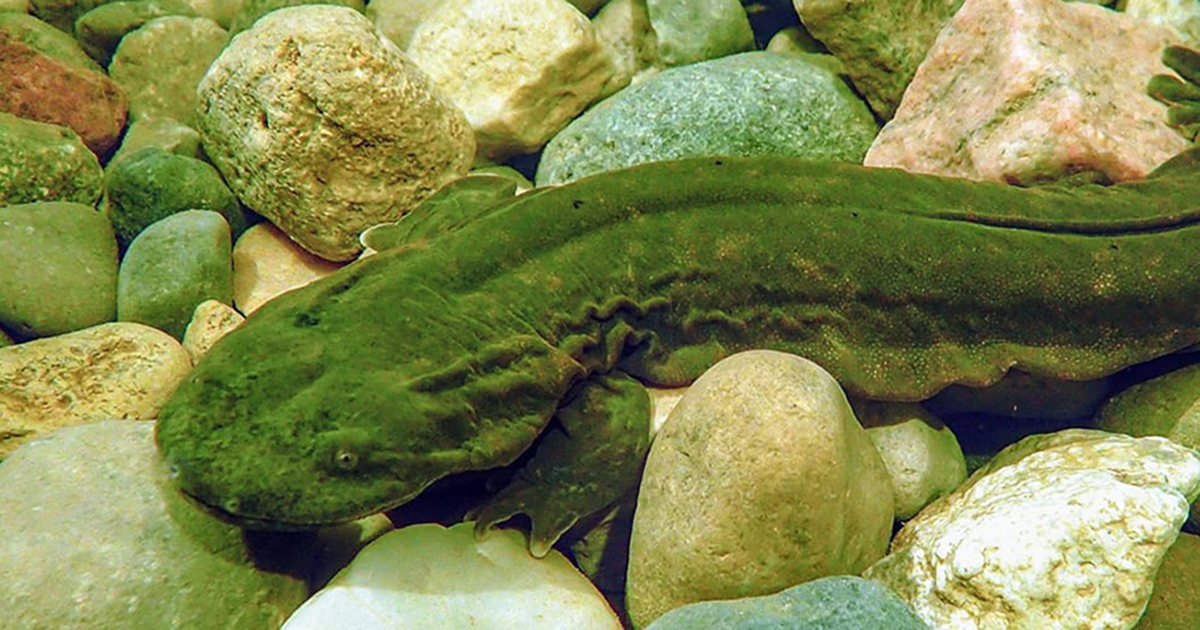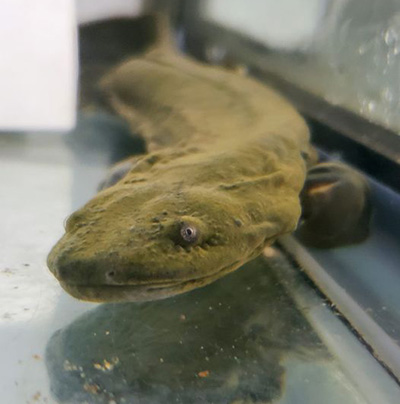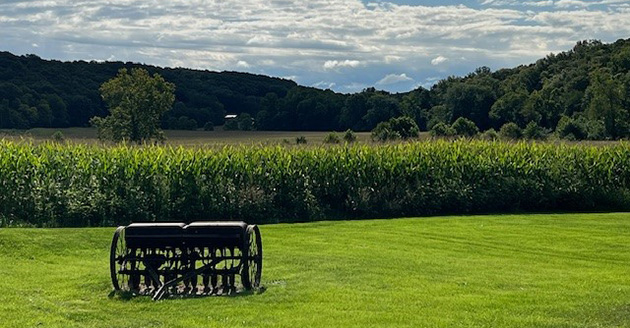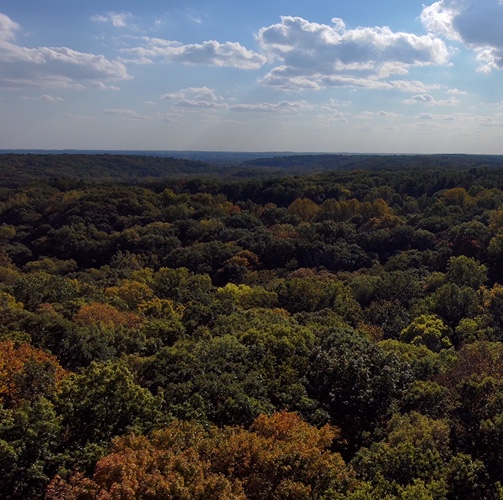“Our partners are experts in their fields and understand the challenges in their own backyards,” Agriculture Secretary Tom Vilsack said. “Through RCPP we can tap into that knowledge, in partnership with producers and USDA, to come up with lasting solutions to the challenges that farmers, ranchers, and landowners face. We’re looking forward to seeing the results of public-private partnership at its best, made possible through these RCPP investments.”

The “Farmers Helping Hellbenders” project, led by Dr. Rod Williams and Purdue Extension wildlife specialist/Help the Hellbender project coordinator Nick Burgmeier, is among the projects set to receive funding through the RCCP Classic fund, which uses NRCS contracts and easements with producers, landowners and communities in collaboration with project partners.
Fourteen contributing partners will assist in the project:
- Mesker Park Zoo and Botanic Gardens
- Fort Wayne Children’s Zoo
- Indianapolis Zoo
- Indiana Department of Environmental Management
- Crawford County Soil and Water Conservation District
- Floyd County Soil and Water Conservation District
- Harrison County Soil and Water Conservation District
- Washington County Soil and Water Conservation District
- Crawford County Cattleman’s Association
- Harrison County Cattleman’s Association
- Washington County Cattleman’s Association
- Cryptobranchid Interest Group
- The Nature Conservancy
- Wallace Center at Winrock International
With help from nearly $2.7 million in RCCP funding, the project aims to improve hellbender habitat in a four-county region in south central Indiana, the only remaining habitat for hellbenders in the state, by expanding the use of agricultural conservation practices that lead to decreased sedimentation in local rivers systems.
Sedimentation is a major cause of hellbender decline and reduced sedimentation will increase available habitat for hellbenders, mussels, and aquatic macroinvertebrates. This project also will address soil and nutrient loss, which are concerns for agricultural producers, as the targeted conservation practices and systems have been shown to have long-term benefits for agricultural systems and operations.
“Through this initiative, focused on Crawford, Floyd, Harrison, and Washington counties, we expect to improve water quality and aquatic wildlife habitat,” Burgmeier said. “Simultaneously, we hope to improve soil retention and nutrient availability to crops by helping farmers implement practices such as cover crops, riparian buffers, grassed waterways, etc. Additional benefits will include increases in riparian and pollinator habitat and increased protection for karst habitat through the selected targeting of sinkholes.”
As part of each project, partners offer value-added contributions to amplify the impact of RCPP funding in an amount equal to or greater than the NRCS investment. Private landowners can apply to participate in an RCPP project in their region through awarded partners or at their local USDA service center.
“RCPP puts local partners in the driver’s seat to accomplish environmental goals that are most meaningful to their community. Joining together public and private resources also harnesses innovation that neither sector could implement alone,” Indiana NRCS State Conservationist Jerry Raynor said. “We have seen record enrollment of privately owned lands in NRCS’ conservation programs and RCPP will be instrumental in building on those numbers and demonstrating that government and private entities can work together for greater impacts on Indiana’s communities.”
For much of the last 16 years, Williams and his team have been researching eastern hellbenders, spearheading regional conservation efforts and advancing hellbender captive propagation, or the rearing of this ancient animal in captivity and their eventual return to the wild.
After five years of breeding efforts, Williams’ partners at the Mesker Park Zoo in Evansville, Indiana, successfully bred eastern hellbenders naturally in captivity in October 2020, signifying the culmination of a long and collaborative effort to breed the species and restore this endangered species to its native environment.
“Wildlife conservation, as a science, is complex,” Williams said. “It requires talent and expertise across a wide range of disciplines and topics: applied science, education and outreach, community partnerships, and landowner support. This RCPP project builds upon 16 years of partnerships, from university researchers to Extension educators, zoos, non-governmental organizations, and state agency professionals. Each partner brings a special talent, community asset, and passion to Eastern Hellbender Conservation. This project will highlight how conservation professionals can pair with landowners to the benefit of all. We are very excited about moving forward.”
Eastern hellbenders, the largest salamanders in North America, breathe through capillaries near the surface of their skin, absorbing oxygen directly from the water. This requires high quality streams and the species has struggled to survive after decades of declining water quality and habitat degradation. Because of these factors, hellbenders are often seen as canaries in the coal mine (or salamanders in the stream as it were) when it comes to water quality. The eastern hellbender (Cryptobranchus alleganiensis alleganiensis) is a large, fully aquatic salamander, nicknamed the snot otter, water dog, devil dog, Allegheny alligator and water eel among other things.
The eastern hellbender (Cryptobranchus alleganiensis alleganiensis) is a large, fully aquatic salamander, nicknamed the snot otter, water dog, devil dog, Allegheny alligator and water eel among other things.
Characterized by flat bodies and heads, slimy blotchy brown skin with folds along the sides that are often said to resemble lasagna noodles, and long tails, eastern hellbenders live in shallow, fast-flowing, cool, rocky rivers and streams across the United States from New York to Georgia and as far west as Missouri and Arkansas. At maturity, the species can measure approximately two feet long.
The efforts of Williams’ lab and other regional partners were recently featured in a documentary titled Hellbender in the Blue.
Hellbender partners featured in the film include Purdue FNR, Evansville Zoological Society, The Association of Zoos and Aquariums, Clark Waldrum Conservation fund, Pittsburgh Zoo and PPG Aquarium, PPG Conservation and Sustainability Fund, and the AZA Amphibian Taxon Advisory Group's Small Grant Fund.
Williams’ hellbender lab is actively collaborating with the Indiana Department of Natural Resources, Indiana Division of Fish and Wildlife and The Nature Conservancy as well as several other partners across 13 states on a number of conservation projects and educational opportunities for teachers and children, farmers and more.
For more information on the eastern hellbender, visit the Help the Hellbender website.
Additional Resources
- Improving Water Quality by Protecting Sinkholes on Your Property video
- Improving Water Quality Around Your Farm video
- Adaptations for Aquatic Amphibians
- Hellbenders Rock! Nature of Teaching Lesson Plan
- Nature of Teaching - Hellbenders Rock Sneak Peek video
- Nature of Teaching - Hellbenders Rock webinar video
- The Hellbender was highlighted by the Alliance for America’s Fish and Wildlife in its promotion efforts for the Recovering America’s Wildlife Act. https://www.fishwildlife.org/story-map-rawa and https://www.youtube.com/watch?v=XsxKhZvDtYM
- Helping the Hellbenders, Indianapolis Zoo
- Learn about hellbenders and take a tour of Purdue’s hellbender rearing facility video
- Learn about the hellbender work at Mesker Park Zoo video
- Learn about hellbender work at The Wilds video
- View Dr. Rod Williams’ 2017 TEDx Talk Help the Hellbenders video
- A Moment in the Wild - Hellbender Hides video
- A Moment in the Wild - Hellbender Release video
About RCPP
First authorized in the 2014 Farm Bill, RCPP has leveraged partner contributions of more than $1 for every $1 invested by USDA, resulting in nearly $3 billion collectively invested in natural resource conservation on private lands. Since inception, RCPP has made 589 awards involving over 3,000 partner organizations. Currently there are 401 active projects, with at least one active project in every state and area. Successful RCPP projects provide innovative conservation solutions, leverage partner contributions and offer impactful and measurable outcomes.
The projects funded are awarded under two different RCPP funding opportunities: RCPP Classic and RCPP Alternative Funding Arrangements (AFA). RCPP Classic projects are implemented using NRCS contracts and easements with producers, landowners and communities, in collaboration with project partners. Through RCPP AFA, partners have more flexibility in working directly with agricultural producers to support the development of new conservation structures and approaches that would not otherwise be available under RCPP Classic.
Check out the full list of 2022 RCPP funded projects or view the interactive map.
For more information about RCPP, visit the NRCS website.
RCPP is part of NRCS’ broader effort to engage partners. For example, NRCS recently announced it will invest $35 million this year through the Conservation Innovation Grants (CIG) program. Through CIG, grantees work to address our nation's water quality, water quantity, air quality, soil health and wildlife habitat challenges, all while supporting agricultural production.
About the USDA
USDA touches the lives of all Americans each day in so many positive ways. In the Biden-Harris administration, USDA is transforming America’s food system with a greater focus on more resilient local and regional food production, fairer markets for all producers, ensuring access to safe, healthy and nutritious food in all communities, building new markets and streams of income for farmers and producers using climate smart food and forestry practices, making historic investments in infrastructure and clean energy capabilities in rural America, and committing to equity across the Department by removing systemic barriers and building a workforce more representative of America. To learn more, visit www.usda.gov.





